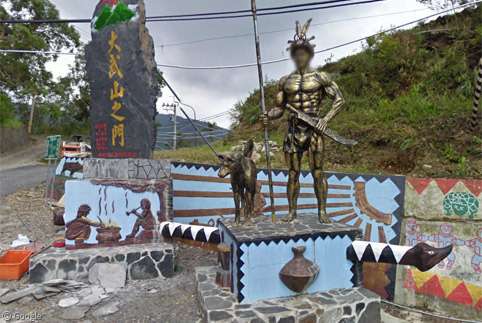Tribal Art of Taiwu Township, Taiwan
Wednesday, 13th October 2010 by Matt Bucher
Taiwan. The Republic of China. Formosa. All three names describe the same island.1 But before the island was settled by Han Chinese or colonised by Europeans, it was inhabited by aborigines. Taiwanese aboriginal people are genetically related to the native peoples of Malaysia and Polynesia—and their hostility to outsiders limited direct colonisation until the 16th century. The aborigines still survive, and number about a half million, living mostly in the central mountainous counties of present-day Taiwan, where they have a rich history of beautiful tribal decoration.
We can see many of their towns on Google Street View, but Taiwu Township (or "Tai Wu") in particular is filled with aboriginal art and symbols. Most of the aborigines in Pingtung County are from the Paiwan tribe, who continue to practice ancestor worship and witchcraft. Many of the brightly coloured symbols include human statues, snakes, monkeys, water jugs, diamonds, and the sun.
Here is a statue posted at the entrance of the village. This statue emphasises both the fierce bravery of the hunter and the ancestors' relationship with animals and nature.
Here is the decorated village gate and the gate to the township elementary school:
One of their most sacred Paiwan symbols is the hundred pacer snake, or Deinagkistrodon. You can see the distinctive diamond-shaped pattern on the back of these snakes:
The diamond pattern appears frequently throughout all the tribal decorations.
A painting of Paiwan ancestors hunting and cooking:
A pole (similar to a totem pole) shows more hunter-ancestors, diamond patterns, snakes, and rabbits.
The Paiwan people, and the other indigenous tribes of Taiwan, have a rich cultural heritage thumbnail of ceremonies, costumes, and artwork. Preserving this heritage is of the utmost importance — and Google Street View gives the rest of the world a window into their world.














Why did Google blur the face of the statue? or is it a real person?